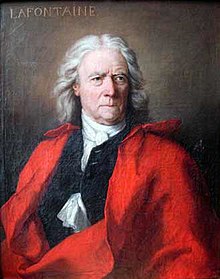August Heinrich Julius Lafontaine (5 October 1758 – 20 April 1831) was a German novelist.
August Lafontaine | |
|---|---|
 Painting by Jean-Laurent Mosnier | |
| Born | 5 October 1758 Braunschweig, Germany |
| Died | 20 April 1831 (aged 72) Halle (Saale), Germany |
| Occupation | writer |
| Nationality | German |
| Notable works | Leben und Thaten des Freiherrn Quinctius Heymeran von Flaming |
Biography edit
Lafontaine was born and brought up in Brunswick, the son of the court painter Ludolph Lafontaine and his fifth wife, the court maid-in-waiting Sophie Elisabeth Thorbrügge. He was educated in Helmstedt, where he studied theology, but took no degree.[1] He then acted as a private tutor until 1789. In 1792, he served as a field chaplain in the Prussian army, and in 1800 settled in Halle. He became canon of the Magdeburg Cathedral as a reward for the dedication of one of his books to Friedrich Wilhelm III and Luise.[2][3]
Works edit
The popularity of his novels, which are sentimental and didactic tales of domestic life, was remarkable.[2] In his lifetime, he was the most popular German novelist, his works surpassing by far the popularity of his contemporary Goethe's.[1] He wrote over 150 volumes, using the pseudonyms Gustav Freier, Miltenberg or Selchow.[3] His novels' tone of conservative moralizing sentimentality was regarded with high favor at the court of Prussia.[4] Far less impressed was August Wilhelm Schlegel, writing in Athenaeum in May 1798: "He has indeed become a favourite writer. Lafontaine can never be more than that.... [for his work] lacks poetry, spirit, and romantic verve."[1] Among his more popular works are:[2]
- Der Naturmensch (1791)
- Gemälde des menschlichen Herzen (Paintings of the Human Heart; 1792 and later, 15 vols.)
- Der Sonderling (1793)
- Familiengeschichten (Family Stories; 1797-1804, 12 vols.)
- Saint Julien (1798)
- Fedor und Marie (1805)
- Descriptions of the Life of Man (1811)
- Die Pfarre an der See (The Parsonage on the Lake Side; 1816, 3 vols.)
- Le Confessioni al Sepolcro traduzione dal tedesco, con note e tavole incise in rame; stampato a Roma (1822, 3 vol.)
References edit
- ^ a b c Dirk Sangmeister, Der Lieblingsdichter der Nation..., article in German newspaper Die Zeit no. 31, 1999.
- ^ a b c Gilman, D. C.; Peck, H. T.; Colby, F. M., eds. (1905). . New International Encyclopedia (1st ed.). New York: Dodd, Mead.
- ^ a b Rines, George Edwin, ed. (1920). . Encyclopedia Americana.
- ^ Reynolds, Francis J., ed. (1921). . Collier's New Encyclopedia. New York: P. F. Collier & Son Company.